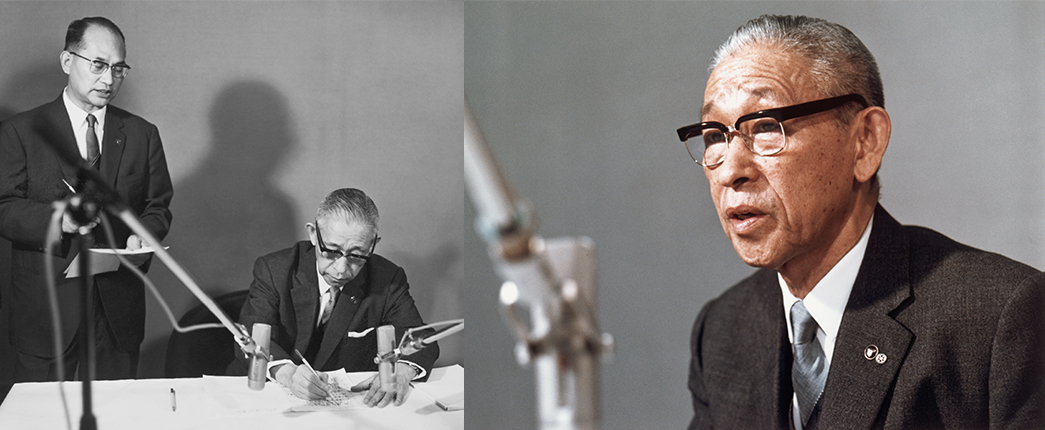
Jan 09, 2026
- Company
- Stories
- Executive Message
- Konosuke Matsushita


Here, we share episodes about Konosuke Matsushita, the founder of the Panasonic Group, from our company's historical records.
The fourth installment in this series introduces the Time Capsule EXPO '70, which was exhibited at the Japan World Exposition, Osaka 1970, and fascinated many visitors, along with Konosuke's words.

This photo shows 2,098 objects selected from the natural sciences, social sciences, and arts from a global perspective by consulting 632 experts from 36 countries as well as seeking public entries from all over Japan.
The first world exposition in Asia was held in Suita City, Osaka, for 183 days from March 15 to September 13, 1970. The Matsushita Group (currently Panasonic Group) exhibited the Matsushita Pavillion. The pavilion, based on an architectural design of the Tenpyo culture*1 from the Nara era, along with Japanese traditional aesthetic elements such as a bamboo grove, a pond, and a tea ceremony room, attracted large crowds, reaching as many as 7.6 million visitors in total.
*1. A Japanese culture that flourished during the Tenpyo years (729 to 749 A.D.) of the Nara era. Numerous temples with graceful roof lines were built during these years.

The Matsushita Pavillion and 70 staff members. Their kimono uniforms, changed for the spring, early summer, and mid-summer seasons, were in perfect harmony with the pavilion's atmosphere, and they were favorably received by many visitors.
What attracted particular attention was the Time Capsule EXPO '70, a project prepared in collaboration with The Mainichi Newspapers. With a view to passing contemporary culture down the generations, two capsules containing 2,098 carefully selected objects were buried in the grounds of Osaka Castle Park.*2 One of them was set to be opened in 6970, 5,000 years later.*3
*2. The site was selected because it would be less affected by future urban development, due to its designation as a historic site in Japan, and because its geological layers are stable.
*3. The documents composing all records of the project were sent to national libraries and museums not only in Japan but also abroad.
On March 15, 1971, the first anniversary of the opening of Expo 1970, Matsushita Electric (currently Panasonic Holdings) and The Mainichi Newspapers held a party at the Osaka Royal Hotel (currently RIHGA Royal Hotel Osaka) for donating the capsules to the Ministry of Education. At the end of the ceremony, Konosuke took the stage and expressed his deep appreciation to all individuals involved for their cooperation, also stating with humor, "This project should prove to be cost-effective, since the name of Matsushita Electric will remain in history 5,000 years from now." The event concluded in a friendly atmosphere.

Left: Time Capsule created by leveraging the best techniques in Japan at the time for casting the capsule, welding the lid, and preserving the objects.
Right: The stainless-steel monument marking the buried site. The capsules will continue to sleep for 5,000 years, 15 meters deep in the ground below the monument.
The objects placed in the capsules included a message from Konosuke (aged 75 at the time) to the people of 5,000 years later, recorded on a pure gold disc to prevent damage. Here is part of his message.
"Today's scientists tell us that the planet is changing year by year. Humanity's conditions of life are also changing moment by moment. We have no way of knowing with any accuracy what the condition of the planet will be 5,000 years from now, and how humanity's way of life will have progressed. We can only imagine various scenarios, but that in itself is part of the fascination of making this capsule.… We sincerely hope you take an interest in these contents, examine them, and enjoy imagining what life was like for the people who made this capsule and left it for you, 5,000 years ago. Thank you, and goodbye."

Konosuke refining the text of his message (left). He spent more than five minutes recording it, with a slightly tense look.
Konosuke later stated, "This project might represent the only living history within this Expo. I am confident that it was one of the productive projects."
The grand project will leave evidence of advances as of 1970 for the far future and deliver invaluable significance to the people living 5,000 years from then.

Konosuke cutting the opening ribbon of the Matsushita Pavilion. Isoya Yoshida, the architect who planned the new main hall of Chuguji Temple in 1968, designed the pavilion at Konosuke's request.
The content in this website is accurate at the time of publication but may be subject to change without notice.
Please note therefore that these documents may not always contain the most up-to-date information.
Please note that German, Spanish and Chinese versions are machine translations, so the quality and accuracy may vary.